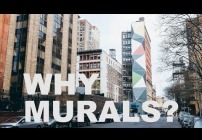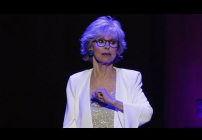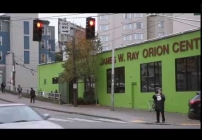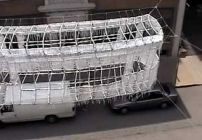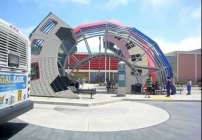Pharaoh's Dance
PROJECT OVERVIEW

Pharaoh's Dance was inspired by three very diverse sources - The African King Mansu Musa, Miles Davis' 1970's jazz hit, Pharaoh's Dance, and the cubist forms of the architecture of the center. With this eclectic mixture of inspiration, Moore has given the southwest corner of the Carnival Center for the Performing Arts a whimsical plaza, serving as a gathering place and area for outdoor performances. Pharaoh's Dance is a permanent outdoor installation composed of four sections; The Sand of the Sahara, The Turntable, Coins of Pharaoh, and Sekhet-Hetepet: Field of Reeds. Represented in ten vibrant colors, Moore refers to the Sands of the Sahara as the 6,000 sq. ft. exterior plaza composed of rustic terrazzo. The abstract designs layered on top of a two-tone red background symbolize the path of Pharaoh Mansa Musa's caravan across the Sahara Desert. Although visitors will find compact compositions placed throughout the design, the artist took care to not have "complete" areas of design and avoided any figurative references. The resulting composition is more like an abstract painting on the ground rather than a form of graphic design. The departure of figurative reference and focus on abstraction is a new development in Moore's work. This commission represents his first large scale abstract work, moving dramatically away from his figurative and highly narrative compositions. The work is composed specifically for the site and the drama and elegance of ballet and opera is reflected in the concise and crisp compositions. Perhaps the most playful element in Moore's plaza is The Turntable, a 12’ circular concrete platform with fused glass panels and colored lights, literally rising out of the center of Sands of the Sahara. As Moore envisions, "this is where the Pharaoh's DJ's will spin and scratch for the Caravan's evening parties." The fused glass panels on the Turntable's riser, which is composed of rustic terrazzo, is detailed with colored circles that mimic the circular forms found in the Sands of the Sahara. The glass panels are lit from behind and in the evening provide a subtle, club-like lighting atmosphere, providing the perfect space for an outdoor party under the stars. Seven polished steel medallions comprise the Coins of Pharaoh, each measuring two feet in diameter. Each of the seven designs is titled and is meant to be seen as an individual work of art. Consisting of Isis Corn Harvest, Nubian Water Drum, Lower Egypt Bling, Sun-RA Saturn Starship, Pharaohs Dance (the signature work) and The Watusi Wiggle, each of the Coins of Pharaoh has its own story. The seat wall and planter filled with black bamboo found on the southern most edge of the Sand of the Sahara is referred to by Moore as the Sekhet-Hetepet: Field of Reeds. In Egyptian mythology, The Field of Reeds is a place where spirits roam. In the context of Pharaoh's Dance and its proximity to the Ballet Opera House, the black bamboo references a reed, a thin strip of material, which vibrates to produce a sound on a musical instrument. Once the Field of Reeds has matured to a seven foot height, one will be able detect a subtle whistling sound as the wind passes through the reeds on breezy days and nights.









